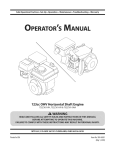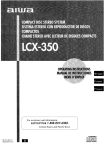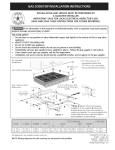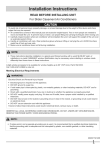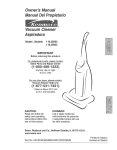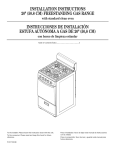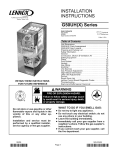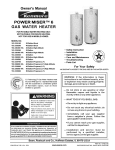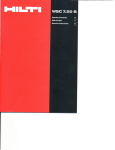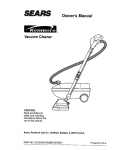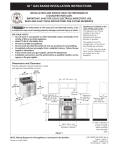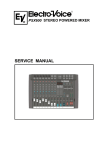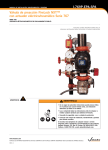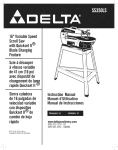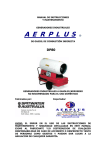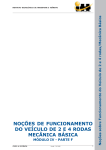Download iNSTALLATiON AND SERVICE MUST BE PERFORMED BY A
Transcript
iNSTALLATiON AND SERVICE MUST BE PERFORMED BY A QUALiFiED iNSTALLER. iMPORTANT: SAVE FOR LOCAL ELECTRICAL iNSPECTOR'S USE. READ AND SAVE THESE iNSTRUCTiONS FOR FUTURE REFERENCE. If the information in this manual is not followed exactly, a fire or explosion may result causing property damage, personal injury or death. FOR YOUR SAFETY: --• • • • -- Do not store or use gasoline or other flammable in the vicinity of this or any other appliance. WHAT TO DO IF YOU SMELL GAS: vapors and liquids Do not try to light any appliance. Do not touch any electrical switch; do not use any phone in your building. Immediately call your gas supplier from a neighbor's phone. Follow the gas supplier's instructions. If you cannot reach your gas supplier, call the fire department. Installation and service must be performed by a qualified installer, service agency or the gas supplier. Appliances Installed in the state of Massachusetts: This Appliance can only be installed in the state of Massachusetts by a Massachusetts licensed plumber or gasfitter. This appliance must be installed with a three (3) foot / 36 in. long flexible gas connector. A"T" handle type manual gas valve must be installed in the gas supply line to this appliance. IMPORTANT: Cabinet and countertop width should match the cutout width. Locate Cabinet Doors 1" (2.5 cm) Min. Cutout Opening. " Min. (61 cm Min.) Grounded Junction Box or Wall Outlet Should Be Located 8" to 17" (20.3 cm to 43.2 cm) From Right Cabinet and 2" to 4" (5.1 cm to 10.2 cm) From Floor. Do not install the unit in the cabinet 35 7/8" (91.1cm) 36 5/8" (93cm) 31 5/16" (79.5cm) 28 5/16" (71.9cm) before reading next page. 30_+1/16" (76.2_+0.15cm) 21 3/4" (55.2cm) Min. 22 1/8" (56.2cm) Max 24" (61cm) Min. with 36 5/8" (93cm) Max. 35 7/8" (91.1cm) backguard NOTE: Wiring diagram Printed in United States for these appliances are enclosed in this booklet. P/N 318201681 (0906) Rev. A English - pages 1-11 Espahol - p_iginas 12-22 Wiring Diagrams - pages 23-24 NOTES: _! Do not pinch the power supply cord between the range and the wall. Do not seal the range to the side cabinets. 24" (6! cm) minimum clearance between the cooktop and the bottom of the cabinet when the bottom of wood or metal cabinet is protected by not less than 1/4" (0.64 cm) flame Ot retardant millboard covered with not less than No. 28 MSG sheet metal, 0.015" stainless steel, 0.024" (0.6 mm) aluminum, or 0.020" (0.5 mm) copper. 30" (76.2 cm) minimum clearance when the cabinet is unprotected. For cutouts below 22 7/8"(58.1 (0.4 mm) cm), appliance will slightly show out of the cabinet. Allow at least 19 ¼" (48.9 cm) clearance for door depth when it is open. 22 7/8" (58.1 cm) min. 23 1/4" (59.05 cm) max. (see Note 4) ______ i FRONT OF _F CABINET S 1 1/8" (2.86 cm) -_ Ref. Door Open (see note 5) A Side Panel 35 7/8" (91.1cm) 36 5/8" (93cm) 31 5/16" (79.5cm) 28 5/16" (71.9cm) 30_+1/16" (76.2_+0.15cm) 21 3/4" (55.2cm) Min. 22 1/8" (56.2cm) Max 24" (61cm) Min. with backguard 36 5/8" (93cm) Max. 35 7/8" (91.1cm) withstand important Notes to the Installer 1. Read all instructions contained in these installation instructions before installing range. 2. Remove all packing material from the oven compartments before connecting the gas and electrical supply to the range. 3. Observe all governing codes and ordinances. 4. Be sure to leave these instructions with the consumer. 5. Note: For operation at 2000 ft. elevations above see level, appliance rating shall be reduced by 4 percent for each additional 1000 ft. heat at least 90°F above room temperature without shrinking, warping or discoloring. Do not install the range over carpeting unless you place an insulating pad or sheet of 1/4" (10,16 cm) thick plywood between the range and carpeting. Make sure the wall coverings around the range can withstand the heat generated by the range. Do not obstruct the flow of combustion air at the oven vent nor around the base or beneath the lower front panel of the range. Avoid touching the vent openings or nearby surfaces as they may become hot while the oven is in operation. This range requires fresh air for proper burner combustion. important Note to the Consumer Keep these instructions with your Use & Care Guide for future reference. Never leave children alone or unattended in the area where an appliance is in use. As children grow, teach them the proper, safe use of all appliances. Never leave the oven door open when the range is unattended. IMPORTANT SAFETY INSTRUCTIONS Installation of this range must conform with local codes or, in the absence of local codes, with the National Fuel Gas Code ANSI Z223.1/NFPA .54-latest edition. Stepping, leaning or sitting on the doors or drawers of this range can result in serious injuries and can also cause damage to the range. This range has been design certified by CSA International. As with any appliance using gas and generating heat, there are certain safety precautions you should follow. You will find them in the Use and Care Do not store items of interest to children in the cabinets above the range. Children could be seriously burned climbing on the range to reach items. To eliminate the need to reach over the surface burners, cabinet storage space above the burners should be avoided. Adjust surface burner flame size so it does not extend beyond the edge of the cooking utensil. Excessive flame is hazardous. Do not use the oven as a storage space. This creates a potentially hazardous situation. Never use your range for warming or heating the room. Prolonged use of the range without adequate ventilation can be dangerous. Do not store or use gasoline or other flammable vapors and liquids near this or any other appliance. Explosions or fires could result. In the event of an electrical power outage, the surface burners can be lit manually. To light a surface burner, hold a lit match to the burner head and slowly turn the Surface Control knob to LITE. Use caution when lighting surface burners manually. Reset all controls to the "off" position after using a programmable timing operation. Guide, read it carefully. • Be sure your range is installed and grounded properly by a qualified installer or service technician. • This range must be electrically grounded in accordance with local codes or, in their absence, with the National Electrical Code ANSI/NFPA No. 70--latest edition. See Grounding Instructions. Before installing the range in an area covered with linoleum or any other synthetic floor covering, make sure the floor covering can @ All appliance can tip. • Injury to persons could result. • Install anti-tip bracket packed with your appliance. See installation Instructions. To reduce the risk of tipping of the range, the range must be secured by properly installed anti-tip bracket(s) provided with the range. To check if the bracket(s) is installed properly, grasp the top rear edge of the range and carefully tilt it foward to make sure the range is anchored. FOR MODELS WITH SELF-CLEAN FEATURE: Remove broiler pan, food and other utensils before self-cleaning the oven. Wipe up excess spillage. Follow the predeaning instructions in the Use and Care Guide. Unlike the standard gas range, THIS COOKTOP IS NOT REMOVABLE. Do not attempt to remove the cooktop. 3 | Cabinet of water column pressure (3.5 kPa). The inlet pressure to the regulator must be at least 1 " (.25 kPa) greater than the regulator manifold pressure setting. Examples: If regulator is set for natural gas 4" (10,16 cm) manifold pressure, inlet pressure must be at least 5"(12.60 cm); if regulator has been converted for LP/Propane gas 10"(25,4 cm) manifold pressure, inlet pressure must be at least 11 "(27,9 cm). Construction _ To eliminate the risk of cabinet burns and fire, do not have cabinet storage space above the range. If there is cabinet storage space above range, reduce risk by installing a range hood that projects horizontally a minimum of 5" (12.7cm) beyond the bottom of the cabinet. Leak testing of the appliance shall be conducted according to the instructions in step 4. | Countertop Preparation • The cooktop sides of the range fit over the cutout edge of your countertop. • If you have a square finish (flat) countertop, no countertop preparation is required. Cooktop sides lay directly on edge of countertop. Formed front-edged countertops must have molded edge shaved flat 3/4" (1.9 cm) from each front corner of opening (Figure 1). Tile countertops may need trim cut back 3/4"(1.9 cm) from each front corner and/or rounded edge flattened (Figure 1). The gas supply line should be 1/2" or 3A" I.D. (Interior Diameter) | Seal the openings Seal any openings in the wall behind the range and in the floor under the range after gas supply line is installed. Connect supply the range to the gas Important: Remove all packing material and literature from range before connecting gas and electrical supply. To prevent leaks, put pipe joint sealant on all external pipe threads. Your regulator is in location as shown. (1.9 cm) I Formed or tile countertop trimmed _A" (1.9 cm) back front corners of countertop Figure I Do not at allow regulator to rotate on pipe when tightening fittings. opening. If the existing cutout width is greater than 30-1/16" (76,4 cm), reduce the 3A" (1.9 cm) dimension. • Countertop must be level. Place a level on the countertop, first side to side, then front to back. If the countertop is not level, the range will not be level. The oven must be level for satisfactory baking results. Cooktop sides of range fit over edges of countertop opening. | Provide an adequate PressureRegulator Location Figure 2 Connection to Pressure Regulator The regulator is already installed on the appliance. Do not make the connection too tight. The regulator is die cast. Overtightening may crack the regulator resulting in a gas leak and possible fire or explosion. Gas Supply When shipped from the factory, this unit is designed to operate on 4"(10,16 cm) water column (1.0 kPa) Natural gas manifold pressure. A convertible pressure regulator is connected to the range manifold and MUST be connected in series with the gas supply line. If LP/ Propane conversion kit has been used, follow instructions provided with the kit for converting the pressure regulator to LP/Propane use. Manual Shutoff Valve Care must be taken during installation of range not to obstruct the flow of combustion and ventilation air. Off Flare Union GAS FLOW __ Connector Flare Union Pressure Regulator Access Cap All connections must be wrench-tightened Figure 3 For proper operation, the maximum inlet pressure to the regulator should be no more than 14"(35,56 cm) 4 Assemble the flexibleconnectorfromthe gassupplypipe to the pressure regulatorinthefollowingorder: 1. manualshutoffvalve(notincluded) 2. 1/2" nipple(notincluded) 3. 1/2"flareunionadapter(notincluded) 4. flexibleconnector(notincluded) 5. 1/2"flareunionadapter(notincluded) 6. 1/2" nipple(notincluded) 7. pressure regulator(included) Usepipe-jointcompound madefor usewith Naturaland LP/Propane gasto sealallgasconnections. If flexible connectors areused,becertainconnectors arenot kinked. Thesupplylinemustbeequipped with anapproved manualshutoffvalve.Thisvalveshouldbelocatedin thesameroomasthe rangeandshouldbein a location thatallowseaseof openingandclosing.Donot block access to the shutoffvalve.Thevalveisfor turningon or shuttingoff gasto the appliance. t_ | LP/Propane Gas Conversion This appliance can be used with Natural gas or LP/ Propane gas. It is shipped from the factory for use with natural gas. If you wish to convert your range for use with LP/ Propane gas, use the supplied fixed orifices located in a bag containing the literature marked "FOR LP/PROPANE GAS CONVERSION." Follow the instructions packaged with the orifices for surface, oven and broil burners conversion. The conversion must be performed by a qualified service technician in accordance with the manufacturer's instructions and all local codes and requirements. Failure to follow these instructions could result in serious injury or property damage. The qualified agency performing this work assumes responsibility for the conversion. Failure to make the appropriate conversion can result in serious personal injury and property damage. | Electrical Requirements 120 volt, 60 Hertz, properly grounded dedicated circuit protected by a 15 amp circuit breaker or time delay fuse. Note: Not recommended to be installed with a Ground Fault Interrupt (GFI). Do not use an extension Shutoff Valve Open position Grounding Figure 4 Once regulator is in place, open the shutoff valve in the gas supply line. Wait a few minutes for gas to move through the gas line. Check for leaks, After connecting the range to the gas supply, check the system for leaks with a manometer. If a manometer is not available, turn on the gas supply and use a liquid leak detector (or soap and water) at all joints and connections to check for leaks. Do not use a flame to check for leaks from gas connections. Checking for leaks with a flame may result in a fire or explosion. Tighten all connections as necessary to prevent gas leakage in the range or supply line. Disconnect this range and its individual manual shutoff valve from the gas supply piping system during any pressure testing of that system at test pressures greater than 1/2 psig (3.5 kPa or 14" water column). Isolate the range from the gas supply piping system by closing its individual manual shutoff valve during any pressure testing of the gas supply piping system at test pressures equal to or less than 1/2 psig (3.5 kPa or 14" water column). cord with this range. Instructions IMPORTANT Please read carefully. For personal grounded, safety, this appliance must be properly The power cord of this appliance is equipped with a 3-prong (grounding) plug which mates with a standard 3-prong grounding wall receptacle (see Figure 5) to minimize the possibility of electric shock hazard from the appliance. The wall receptacle and circuit should be checked by a qualified electrician to make sure the receptacle is properly grounded. Preferred Method Grounding type wall receptacl Do not, under any circumstances, cut, remove, or bypass the grounding prong. Power supply cord with 3-prong grounding plug. Figure 5 Wherea standard2-prongwallreceptacle is installed, it isthe personal responsibility andobligationof the consumer to haveit replaced bya properlygrounded 3-prongwallreceptacle. Do not, underany circumstances, cut or removethe third (ground)prongfrom the power cord, _:_[ Ir_j__ Install the anti-tip bracket at this point before placing the range at its final position. Follow the installation instructions on page 11 or 12 or on the anti-tip bracket template supplied with the range. _To provide an optimum installation, the top surface of the countertop must be level and flat (lie on the same plane) around the 3 sides that are adjacent to range cooktop. Proper adjustments to make the top flat should be made or gaps between the countertop and the range cooktop may occur. __ To reduce the risk of damaging your appliance, do not handle or manipulate it by the ceramic glass. Manipulate with care. Disconnect electrical supplycordfrom wallreceptacle beforeservicing cooktop. | Moving the Appliance Servicing and Cleaning for Turn off the range line fuse or circuit breakers at the main power source, and turn off the manual gas shut-off valve. Make sure the range is cold. Remove the service drawer (warmer drawer on some models) and open the oven door. Lift the range at the front and slide it out of the cut-out opening without creating undue strain on the flexible gas conduit. Make sure not to pinch the flexible gas conduit at the back of the range when replacing the unit into the cut-out opening. Replace the drawer, close the door and switch on the electrical power and gas to the range. Range Installation Important Note: Door removal is not a requirement for installation of the range, but is an added convenience. Refer to the Use and Care Guide for oven door removal instructions, Standard Installation Figure 6 cl- _lnstall base cabinets 30" (76.2 cm) apart. Make sure they are plumb and level before attaching cooktop. Shave raised countertop edge to clear 31 1/2" (81 cm) wide range top rim. _lnstall cabinet doors 31 " (78.7 cm) min. apart so it will not interfere with range door opening. For models countertop exactly as shown on page 1. equipped with Leveling range in front of the cabinet opening. _Make sure that the cooktop glass which overhangs the countertop clears the countertop. If necessary, raise the unit by lowering the leveling legs. _Slide the range into the cutout opening and center it before leveling it. _Level the range (see section 9). The floor where the range is to be installed must be level. Follow the instructions under "Leveling the Range- Models Equipped with Leveling Device". _,l_l="J Adjust leveling legs so that the underside of the cooktop is sitting on the countertop. Carefully screw in (refer to Leveling the range: Models equipped with Leveling Device") the back leveling leg until the cooktop glass overhang touches slightly the countertop. Then carefully screw in the front two leveling legs until the cooktop glass overhang touches slightly the countertop. For models equipped with only (no leveling device): OThe range cooktop overlaps the countertop at the sides and the range rests on the floor. The cooktop is 31 1/2" (81 cm) wide. _Cutout |Position Device: |Make sure the front leveling legs and the rear leveling device are setup higher than the height of the cabinet. Levelin Lg_L=eg _Make sure the four leveling legs (front and rear) are setup higher than the height of the cabinet (shown on page 3). |_ Install the anti-tip bracket at this point before placing the range at its final position. Follow the installation instructions on page 11 or 12 or on the anti-tip bracket template supplied with the range. _To provide an optimum installation, the top surface of the countertop must be level and flat (lie on the same plane) around the 3 sides that are adjacent to range cooktop. Proper adjustments to make the top flat should be made or gaps between the countertop and the range cooktop may occur. _ | _J__ To reduce the risk of damaging your appliance, do not handle or manipulate it by the ceramic glass. Manipulate with care. _Position range in front of the cabinet opening. 2. _Make sure that the glass which overhangs the countertop clears the countertop. If necessary, raise the unit by lowering the leveling legs. _Eevel the range (see section 9). The floor where the range is to be installed must be level. Follow the instructions under "Leveling the Range-Models Equipped with Leveling Legs". _Slide Models Equipped with 3. Needed Installation With Backguard A backguard kit can be ordered through a Sears Service Center. The cutout depth (213A" (5B,2cm) Min., 221/s'' (56,2cm) Max.) needs to be increased to 24" (61cm) when installing a backguard Installation With End Panel An end panel kit can be ordered through a Sears Service Center. ust Rear Levelin¢ Installation With Side Panel A side panels kit can be ordered through a Sears Service Center. Install cabinet doors 31 " (78,7cm) min. apart so as not to interfere with range door opening. Levelin Leveling the Range Models Equipped with Leveling Device Font Leveling Leg Level the range after installation in the cutout opening. 1. Open the range drawer. The leveling screws control the height of the rear leg. 2. Adjust the appliance legs as follows until the underside of the cooktop (or cooktop glass) surface is sitting level on the countertop (Figure 7). a.To adjust the front legs, use a wrench on the leg base and turn counterclockwise to lower or clockwise to raise the range. b.To adjust the rear legs, use a ratchet or a nutdriver and turn the leveling screws counterclockwise to lower or clockwise to raise 3. 4. 5. Legs Place a level on the rack (see Figure 8). Take 2 readings with the level placed diagonally in one direction and then the other. Level the range, if necessary, by adjusting the 4 leg levelers with a wrench (see Figure 17). Taking care to not damage the countertop, slide range into cutout opening and double check for levelness. the range into the cutout opening. lf Accessories Leveling Level the range and set cooktop height before installation in the cut-out opening. 1. Install an oven rack in the center of the oven. Figure 7 the range. Check if the range is level by installing an oven rack in the center of the oven and placing a level on the rack (Figure 8). Take 2 readings with the level placed diagonally in one direction and then the other. Level the range, if necessary, by adjusting the leveling legs. If the range cannot be level, contact a carpenter to correct sagging or sloping floor. Figure 8 7 Decorative Rear Trim Installation Main (if required) 1. 2. 3. 4. Disconnect the power from the range. Make sure the range is leveled. Pull range toward you. Measure the distance between the floor and the surface underneath the cooktop frame. Mark that distance on the wall where the decorative trim will be installed. Draw a line. Place the top of the decorative trim under that line. Using the screws provided fix the decorative trim into the wall. Slide the range back into position as far as it will go and reconnect the power source. 5. 6. 7. 8. 9. Turn between the floor and the "'-.. "<_ame, Figure 9 Gas Valve position. You will hear the igniter sparking. b. The surface burner should light when gas is available to the top burner. Each burner should light within four (4) seconds after air has been purged from supply lines. Visually check that burner has lit. c. Once the burner lights, the control knob should be rotated out of the LITE position. There are separate ignition devices for each burner. Try each knob separately until all burner valves have been checked. Adjust the "LOW" Setting Check Operation Refer to the Use and Care Guide packaged with the range for operating instructions and for care and cleaning of your range. Remove all packaging from the oven before testing. Install This range as shown Burner Bases is equipped (see Open of Surface ignites. b. Quickly turn knob to LOWEST POSITION. c. If burner goes out, readjust valve as follows: Reset control to OFF. Remove the surface burner control knob, insert a thin-bladed screw driver into the hollow valve stem and engage the slotted screw inside. Flame size can be increased or decreased with the turn of the screw. Adjust flame until you can quickly turn knob from LITEto LOWEST POSITION without extinguishing the flame. Flame should be as small as possible without going out. surface underneath the cooktop \.. and Burner Valves (see Figure 11) a. Push in and turn each control to LITE until burner "¸ zz_stance J Shutoff Power Check the Igniters Operation of electric igniters should be checked after range and supply line connectors have been carefully checked for leaks, and range has been connected to electric power. To check for proper lighting: a. Push in and turn a surface burner knob to the LITE | ii on Electrical Figure and with Burner Caps sealed burners 10). a. Unpack burner bases and burner caps. b. Place burner bases over each gas opening. c. Make sure the burner is properly aligned and leveled. Place burner caps over appropriate burner bases. NOTE: There are no burner adjustments necessary on this range. Figure 11 i i Figure 10 | front of oven bottom from oven front frame, and pull the oven bottom out of the oven. Remove burner baffle so that burner flame can be observed. Operation of Oven Burners and Oven Adjustments 11.5.1 Electric Ignition Burners Operation of electric igniters should be checked after range and supply line connectors have been carefully checked for leaks, and range has been connected to electric power. If the flame is yellow, increase air shutter opening size (see "2" in Figure 13). If the entire flame is blue, reduce the air shutter opening size. To adjust frame loosen lock screw (see "3" in Figure 13), reposition air shutter, and tighten lock screw. Replace oven bottom. Burner Tube The oven burner is equipped with an electric control system as well as an electric oven burner igniter. If your model is equipped with a waist-high broil burner igniter, it will also have an electric burner igniter. These control systems require no adjustment. When the oven is set to operate, current will flow to the igniter. It will "glow" similar to a light bulb. When the igniter has reached a temperature sufficient to ignite gas, the electrically controlled oven valve will open and flame will appear at the oven burner. There is a time lapse from 30 to 60 seconds after thermostat is turned ON before the flame appears at the oven burner. When the oven reaches the display setting, the glowing igniter will go off. The burner flame will go "out" in 20 to 30 seconds after igniter goes "OFF". To maintain any given oven temperature, this cycle will continue as long as the display is set to operate. After removing all packing materials and literature from the oven: a) Set the oven to BAKE at 300% See Use & Care Guide for operating instructions. b) Within 60 seconds the oven burner should ignite. Check for proper flame, and allow the burner to cycle once. Reset controls to off. c) If your model is equipped with a high-waist broiler, set oven to broil. See Use & Care Guide for operating instructions. d) Within 60 seconds the broil burner should ignite. Check for proper flame. Reset controls to off. 11.5.2 Air Shutter-Oven L wer Oven Baffle ( Figure 12 Lock Screw Air Shutter _ 11.5.3 Air Shutter-Broil )Orifice Hood Figure 13 Burner The approximate flame length of the burner is 1 inch (distinct inner cone of blue flame). To determine if the broil burner flame is proper, set the oven to broil. If flame is yellow, increase air shutter opening size (see "2" in Figure 13 ). If the entire flame is blue, reduce the air shutter opening size. To adjust, loosen lock screw (see "3" in Figure 13), reposition air shutter, and tighten lock screw. When All Hookups are Complete Make sure all controls are left in the OFF position. Make sure the flow of combustion and ventilation air to the range is unobstructed. Model and Serial Number Location The serial plate is located on the oven front frame behind the oven door (some models) or on the drawer side frame (some models). Burner When ordering parts for or making inquiries about your range, always be sure to include the model and serial numbers and a lot number or letter from the serial plate on your range. Waist-High Shutter Burler / Your serial plate also tells you the rating of the burners, the type of fuel and the pressure the range was adjusted for when it left the factory. Lower Oven Bottom _=-Air Shutter (removable) Before The approximate oven burner flame length is 1 inch (distinct inner cone of blue flame). You Call for Service Read the Before You Call Checklist and operating instructions in your Use and Care Guide. It may save you time and expense. The list includes common occurrences that are not the result of defective workmanship or materials in this appliance. To determine if the oven burner flame is proper, remove the oven bottom and burner baffle and set the oven to bake at 300% To remove the oven bottom, remove oven hold down screws at rear of oven bottom. Pull up at rear, disengage Refer to your Use & Care Guide for Sears service phone numbers or call 1-800-4-MY-HOME®. 9 | Anti-Tip Brackets 1. Draw a center line (CL) on the floor where the range should be installed. Also draw a line on the floor at the Installation instructions | Models Equipped with Leveling range back position if there is no wall. 2. Unfold paper template and place it flat on the floor with the right rear corner positioned exactly on the intersection of the center and back lines you just drew before. (Use the diagram below to locate brackets if template is not available (Figure 14)). 3. Mark on the floor the location of the 4 mounting holes shown on the template. For easier installation, 3/16"(0,48 cm) diameter pilot holes 1/2"(1,27 cm) deep can be drilled into the floor. 4. Remove template and place bracket on floor. Line up holes in bracket with marks on floor and attach with Device To reduce the risk of tipping of the range, the range must be secured to the floor by properly installed anti-tip bracket and screws packed with the range. These parts are located in the oven. Failure to install the anti-tip bracket will allow the range to tip over if excessive weight is placed on an open door or if a child climbs upon it. Serious injury might result from spilled hot liquids or from the range itself. Follow the instructions below to install the anti-tip brackets. 4 screws provided. Bracket must be secured to solid floor (Figure 15). If attaching to concrete floor, first drill 3/16"(0,48 cm) dia. pilot holes using masonry drill bit. 5. Be sure the 4 leveling legs are at the highest position they can be. 6. Slide range into place making sure structure of the range is trapped by the anti-tip bracket (Figure 14). Lower the range by adjusting the 4 leveling legs until the underside of the cooktop is sitting level on the countertop. Refer to "Leveling the Range" section. 7. After installation, verify that the anti-tip bracket is engaged by grasping the top rear edge of the range and carefully attempt to tilt it forward to make sure range is properly anchored. If range is ever moved to a different location, the antitip brackets must also be moved and installed with the range. Tools Required: Adjustable Wrench Ratchet Drill & 1/8"(0,32 cm) bit 5/16" (0,8 cm) Nutdriver Level The anti-tip bracket attaches to the floor at the back of the range to prevent range from tipping. When fastening bracket to the floor, be sure that screws do not penetrate electrical wiring or plumbing. The screws provided will work in either wood or concrete. i} i} i} i} i} Floor Mount_ Screws Figure 15 BACK Figure 14 10 | 1. Models Equipped with Levelin To reduce the risk of tipping of the range, the range must be secured to the floor by properly installed anti-tip brackets and screws packed with the range. These parts are located in a plastic bag in the oven. Failure to install the anti-tip brackets will allow the range to tip over if excessive weight is placed on an open door or if a child climbs upon it. Serious injury might result from spilled hot liquids or from the range itself. 2. 3. Follow the instructions below to install the anti-tip brackets. If range is ever moved to a different location, the antitip brackets must also be moved and installed with the range. To check for proper installation, see step 5. 4. Tools Required: 5/16" (0,79 cm) Nutdriver or Flat Head Screwdriver Adjustable Wrench Electric Drill 5. 3/1 6"(0,5 cm) Diameter Drill Bit 3/1 6"(0,5 cm) Diameter Masonry Drill Bit (if installing in concrete) Brackets attach to the floor at the back of the range to hold both rear leg levelers. When fastening to the floor, be sure that screws do not penetrate electrical wiring or plumbing. The screws provided will work in either wood or concrete. Unfold paper template and place it flat on the floor with the back and side edges positioned exactly where the back and sides of range will be located when installed. (Use the diagram below to locate brackets if template is not available. (Figure 16)) Mark on the floor the location of the 4 mounting holes shown on the template. For easier installation, 3/16" (0.5 cm) diameter pilot holes 1/2" (1.3 cm) deep can be drilled into the floor. Remove template and place brackets on floor with turned up flange to the front. Line up holes in brackets with marks on floor and attach with 4 screws provided. Brackets must be secured to solid floor. If attaching to concrete floor, first drill 3/16" (0.5 cm) dia. pilot holes using a masonry drill bit. Level range if necessary, by adjusting 4 leg levelers with wrench (Figure 17). A minimum clearance of 1/8" (0.8 cm) is required between the bottom of the range and the rear leg levelers to allow room for the anti-tip brackets. Slide range into place making sure rear legs are trapped by ends of brackets. Range may need to be shifted slightly to one side as it is being pushed back to allow rear legs to slide under brackets. You may also grasp the top rear edge of the range and carefully attempt to tilt it forward to make sure range is properly anchored. i Anti-tip Bracket Back Edgeof Range or RearWall _ - CL.,-" = .9 <'4_' 1/8" _. (23.2 cm) " /".. Anti-tip Bracket 18'4 '''_" .(46.4 cm) /.._r" - 28 1/8" '-, _,j(71.4 cm) (Rearwidth of range with body sides) (eL = Center line Figure 17 Slide Back Figure 16 11 LA INSTALACION Y EL SERVICIO DEBEN SER EFECTUADOS POR UN INSTALADOR CALIFICADO IMPORTANTE: GUARDE ESTAS INSTRUCCIONES PARA USO DEL iNSPECTOR LOCAL DE ,//7" __ ELECTRiCiDAD. LEA Y GUARDE ESTAS 'NSTRUCC'ONES PARA... REFERENC'A FUTURA. A -':'\, "\, (, ) IF_ Si Jainformaci6n contenida en este manual no es seguida exactamente, puede ocurrir un incendio o expJosi6n causando daEos materiaJes, Jesionpersonal o Jamuerte. "L._ PARASU SEGURIDAD: -- No aJmaceneni utiJice gasoJina u otros vapores y JiquidosinflamabJesen Ja proximidad de _ste o de cuaJquier otro artefacto. -- QUE DEBEHACERSJPERCIBE OLORA GAS: • No trate de encender ningun artefacto. • No toque ningun interruptor eJ_ctrico; no use ningun teJ_fono en su edificio. • LJamea su proveedor de gas desde eJteJ_fono de un vedno. Siga Jas instruccionesdel proveedor de gas. • Si no Jogracomunicarsecon su proveedor de gas, JJameaJdepartamento de bomberos. -- La instaJaciony el servido de mantenimiento deben ser efectuados por un instaJadorcaJificado, Jaagenda de servido o el proveedor de gas. Aparatos InstaJados en el estado de Massachusetts; Este Aparato sOlo puede set instalado en el estado de Massachusetts por un plomero o ajustador de gas licenciado de Massachusett. Este aparato se debe instalar con un largo conector flexible de gas de tres (3) pies/36 pulgadas. Una wqlvulamanual de gas de tipo manija de forma de "T" sedebe instalar en la linea del suministro de gas de este aparato. E 30" Min. J_(76.2 La superfide debe estar plana y niveJada IMPORTANTE: El ancho de la cubierta y el armario debe de set igual al ancho deJ corte. M[n. 5 ' 1 1/2"M_ix _" • (3.8 cm M_ix.) Acepille el borde _ subido a que / J X II dejeespacio _ para,un borde _ IJ_/A 31 Y2 (81 cm) de _ 7_ anchura de estufa _ I \ ( (12.7cm)de la pared ambos lados... ._,_ - ..---I--_ _-1¢ _ __ L _ 1/2" ,'_ ) J (81 ExactoI I (33 cm) (45.7cm)Min. I - __ / ,_._ . 18" Min. _ 1/_ _1 I Localice las puertas del ---"L. 30" Mrn. _ J:_--31 I I (area sombreada)m_x_ ,..,.... cm Min.) '_1 I _ _/4" rain. _l(2"_nirl. L_.___ _"_--, _ Approx.17/8" _-'L::_ ..... (4.8 cm) : ........ ::j ![ armario 1 (2.5 cm)min del hueco de la abertura. _ JC] #>"" / __tf r_/_...-....... -/ ............. _ / / ",./ La caja de empalmes o el enchufe con puesta a tierr'a deberia situarse de 8" a 17" (20.3 cm a 43.2 cm) del armario derecho y de 2" a 4" (5.1 cm a 10.2 cm) del suelo. No instale la unidad en el gabinete si no ha leido esta p_qgina. 35 7/8" (91.1cm) 36 5/8" (93cm) 30" (76.2cm) 31 5/16" (79.5cm) 28 5/16" (71.9cm) 30 _+ 1/16" (76.2 _+0.15 cm) 21 3/4" (55.2cm) Min. 22 1/8" (56.2cm) Max 36 5/8" (93cm) Max. 35 7/8" (91 .lcm) 24" (61cm) Min. with backguard NOTA: Se adjunta el diagrama Impreso en los Estados Unidos de cables de esta cocina al final de este libreta. P/N 318201681 (0906) Rev. A English - pages 1-11 Espahol - p_qginas 12-22 Diagrama de la instalaci6n alambica - p_iginas 23-24 NOTAS: No pellizque el cordon electrico entre la estufa y la pared. _) No selle la estufa a los armados de lado. Un espacio minimo de 24" (61 cm) entre la superficie de la estufa y el fondo del armario esto cuando el fondo del armado de madera o metal est,1 protegido pot no menos de 1/4" (0.64 cm) de madera resistente al fuego cubierta pot una I_imina _) met_ilica de MSG, n0mero 28, 0.015" (0.4 mm) de acero inoxidable, 0.024" (0.6 mm) aluminio, 6 0.020" (0.5 ram) de cobre. Un espado minimo de 30" (76.2 cm) cuando el armado no este protegido. _lb Para los recortados menos que 22 7/8", el electrodomestico en el exterior del armado. apareceria ligeramente Deje pot los 19 ¼" (48.9 cm) de espado libre para la profundidad este abierta. de la puerta cuando 22 7/8" (58.1 cm) min. 23 1/4" (59.05 cm) max. ÷ (yea la nota 4) ÷ r" r m PARTE DELANTERA DEL ARMARIO 1 1/8" _(2.86 cm) Ref. Puerta abierta (vea la nota 5) A lateral 35 7/8" (91.1cm) 36 5/8" (93cm) 30" (76.2cm) 31 5/16" (79.5cm) 28 5/16" (71.9cm) 30 _+ 1/16" (76.2 _+0.15 cm) 21 3/4" (55.2cm) Min. 22 1/8" (56.2cm) Max 24" (61cm) Min. with backguard 13 36 5/8" (93cm) Max. 35 7/8" (91 .lcm) Notas importantes para Lea todas las instrucciones contenidas en este manual antes de instalar la estufa. 2. Saque todo el material usado en el embalaje del compartimiento del homo antes de conectar el suministro electrico o de gas a la estufa. Observe todos los cOdigos y reglamentos pertinentes. Deje estas instrucciones con el comprador. Nota: Para la utilizaciOn a m_s de 2 000 pies de altura, la potencia del aparato deber_ ser reducida de 4 por ciento a cada 1 000 pies adicionales. 3. 4. 5. Nota Importante menos que coloque una plancha de material aislante de por Io menos 1/4 pulgada, entre la estufa y la alfombra. , Asegurese de que el material que recubre las paredes alrededor de la estufa, pueda resistir el calor generado por la estufa. , No obstruya el flujo del aire de combustion en la ventilaci6n del homo ni tampoco alrededor de la base o debajo del panel inferior delantero de la estufa. Evite tocar las aberturas o _ireas cercanas de la ventilaciOn, ya que pueden estar muy calientes durante el funcionamiento del homo. La estufa requiere aire fresco para la combusti6n apropiada de los quemadores. el Instalador 1. para el Consumidor Conserve estas instrucciones y el Manual del Usuario para referencia futura. en un area donde Nunca deje ni_os solos o desatendldos un artefacto esta siendo usado. A medida que los niflos crecen, ensefleles el uso apropiado y de seguridad para todos los artefactos. Nunca deje la puerta del homo abierta cuando la estufa est,1desatendida. IMPORTANTES INSTRUCCIONES DE SEGURIDAD No se pare, apoye o siente en las puertas o cajones de esta estufa pues puede resultar en serias lesiones y puede tambien causar daEo a la estufa. o No almacene articulos que puedan interesar a los niBos en los gabinetes sobre la estufa. Los niflos pueden quemarse seriamente tratando de trepar a la estufa para alcanzar estos articulos. Instalaci6n de esta estufa debe cumplir con todos los c6digos locales, o en ausencia de c6digos locales con el C6digo Nacional de Gas Combustible ANSI Z223.1/NFPA .54--01tima edici6n. , Los gabinetes de almacenamiento sobre la estufa deben set evitados, para eliminar la necesidad de tenet que pasar sobre los quemadores superiores de la estufa para Ilegar a ellos. Ajuste el tama_o de la llama de los quemadores superiores de tal manera que esta no sobrepase el borde de los utensilios de cocinar. La llama excesiva es peligrosa. , No use el horno como espacio de almacenaje. Esto crear_i una situaciOn potencialmente peligrosa. Nunca use la estufa para calentar el cuarto. El uso prolongado de la estufa sin la adecuada ventilaciOn puede resultar peligroso. o No almacene ni utilice gasolina u otros vapores y liquidos inflamables en la proximidad de este o de cualquier otto artefacto electrico. Puede provocar incendio o explosi6n. En caso de una interrupti6n del servicio electrico, es posible de encender los quemadores de superficie a mano. Para encender un quemador de superficie, acerque un f6sforo encendido del cabezal del quemador, y gire delicadamente el bot6n de control de superficie a LITE(encendido). Tener cuidado al encender los quemadores a mano. Ajuste todos los controles a la posici6n "OFF" (apagada) despues de haber hecho una operacion con tiempo programado. El diseflo de esta estufa ha sido certificado por la CSA Internacional. En _ste como en cualquier otro artefacto que use gas y genere calor, hay ciertas precauciones de seguridad que usted debe seguir. Estas ser_in encontradas en el Manual del Usuario, I_alo cuidadosamente. , Asegurese de que la estufa sea instalada y conectada a tierra en forma apropiada por un instalador calificado o pot un tecnico. , Esta estufa debe set electricamente puesta a tierra de acuerdo con los c6digos locales, o en su ausencia, con el C6digo Electrico Nacional ANSI/NFPA No. 70, ultima edici6n. Yea las instrucciones para la puesta a tierra en la p_igina 4. o Antes de instalar la estufa en un area cuyo piso este recubierto con lin6leo u otro tipo de piso sintetico, asegurese de que estos puedan resistir una temperatura de pot Io menos 90°F sobre la temperatura ambiental sin provocar encogimiento, deformaci6n o decoloraci6n. No instale la estufa sobre una alfombra al • Todas las estufas pueden volcarse. • Esto podria resultar en lesiones personales. • Instale el dispositivo anti vuelcos que se ha empacado junto con esta estufa. PARA MODELOS AUTOLIMPIANTES: Saque la asadera, alimentos o cualquier otto utensilio antes de usar el cido de autolimpieza del homo. Limpie todo exceso de derrame de alimentos. Siga las instrucciones de prelimpiado en el Manual del Usuario. • A diferencia de la gama estandar cocinas de gas, ESTA PLANCHA DE COCINA NO ES MOVIBLE. No intente quitar la plancha de cocina. vuelque la estufa, hay que asegurarla adecuadamente colo candole los soportes Para reducirque el riesgo de que se Para antivuelco se proporcionan. comprobar si estos estan instalados y apretados en su lugar como se debe, ase el borde trasero superior de la estufa y cuidado samente incline la hacia adelante para asegurar que la estufa se ancle. 14 roll Construcci6n Para la operaci6n apropriada, la m_ixima presi6n de entrada al regulador no debe execeder la presi6n de una columna de agua de 14"(35,56 cm) (3.5 kPa). La presi6n de entrada al regulador debe set por Io menos 1" (.25 kPa) m_is grande que la wilvula distribuidora.Ejemplos: Si regulador se pone para el gas natural con una presi6n de 4"(10,16 cm), la presi6n de entrada al regulador debe set por Io menos 5"(12.60 cm); si el regulador se ha convertido para gas LP/Propane 10"(25,4 cm)la presi6n de entrada al regulador debe set pot Io menos 11"(27,9 del armario F_ Para eliminar el riesgo de quemaduras o de fuego tratando de alcanzar algo pot encima de las zonas calientes, evite de colocar articulos sobre la cocina. Si cree necesitar este espacio, el riesgo puede disminuir si instala un sombrerete que proteja horizontalmente un minimo de 5" (12.7cm) sobre la base del armario. | Preparacion del mostrador • Las extremidades de la cocina sobrepasan el horde de su mostrador. Si tiene un mostrador con las extremidades cuadradas (planas), no se necesita ninguna preparaci6n del mostrador. El reborde de frente de mostradores moldeados deben tenet hordes moldeados a 3/4" (1 .gcm) a partir de cada extremidad de la apertura (Figura 2). Los mostradores enazulejos deber_in necesitar un recorte de 3/4" (1.9 cm) a partir de cada extremidad y/o un horde redondeado aplanado (Figura 2). cm). Un examen de detection de fugas del aparato debe set realizado segOn las instrucciones en el paso 4. La linea de fuente de gas debe set de 1/2" o de 3A". | Selle las aperturas sella todas las aperturas en la pared detr_is de la estufa y en el suelo debajo de la estufa despu@sque la linea del suministro de gas sea instalada. Conecte la estufa al suministro de gas Importante: Quite todo el material de embalaje y literatura de la estufa antes de conectar el gas y la fuente el@ctrica. 31_/,,_ (81 cm) recortado / Para evitar fugas, aplique sellador de tuberias en _ en las esquinas (1.9 cm) I • Si el ancho abertura Figura 1 de la abertura todas las partes roscadas machos (exterior) de la tuberia. El regulador se encuentra en el lugar que se muestra en la ilustraci6n. (Figura 4) moldeado o enazulejo 3/4" (1.9 cm) hada atr&s del de frente de la del mostrador. mostrador es mas grande que 30 1/16" (76,4 cm), ajuste a las dimensiones como para el 3/4" (1.9). El mostrador deber ser nivelado. Coloque un nivelador sobre el mostrador, primero de lado a lado y luego del frente hacia atr_is. Si el mostrador no est,1 nivelado, la cocina no estate1 nivelada. El homo debe ser nivelado para tenet resultados satisfactorios al hornear. Las extremidades de la plancha de la cocinar sobrepasan los hordes de la abertura del mostrador. Proporcione adecuado un suministro F .__ No permita que el regulador gire sobre la tuberia al apretar las uniones. UbicaciOn del regu _dor de presiOn Figura 2 Conecte el Regulador de Presion El regulador de presi0n esta ya instalada para la estufa. No haga la conexi6n demasiado apretada. El regulador es de die cast. El apretar demasiado puede agrietar el regulador dando pot resultado una fuga de gas y un fuego o una explosi6n. Valvula de FLUJO DEL GAS Regulador _ cierre Uni6n Uni6n de presi6n manual ,_ de gas Cu_indo se envia de la f_ibrica, esta unidad ha sido ajustada para operar con un mOltiple de admisi6n para gas natural de 4" (10.16 cm)(1.0 kPa). Un regulador de presi6n convertible esta conectado a la wilvula distribuidora y DEBEset conectado con la tuberia del suministro de gas. Si el juego de conversi6n del propano LP/Propano se ha utilizado, sigue las instrucciones proporcionadas el juego para convertir el regulador de presi6n al uso de LP/Propano. (On) _ Boquilla Apagado (Off) se debe de tenet cuidado durante la instalaci6n de la Conector flexible Boquill_ Tapa de entrada Todas las conexiones deben set apretadas con una Ilave inglesa- Figura 3 estufa para no obstruir el flujo de aire de combusti6n y ventilaci6n 15 Re0nael conectorflexibledeltubodelsuministro degas al regulador de lapresiOn en laordensiguiente: 1. V_ilvula decierremanual(noincluido) 2. Boquillade 1/2"(noincluido) 3. 1/2"Adaptadordeunion (noincluido) 4. Conectorflexible(noincluido) 5. 1/2"Adaptadordeunion (noincluido) 6. Boquillade 1/2" (noincluido) 7. reguladordepresiOn(incluido) Useselladorparaunionesdetuberiashechoparael usodegasnaturaly LP/Propane parasellartodaslas conectiones degas.Siseutilizanlosconectadores flexibles,asegures_ dequelosconectadores noest_in enroscados. Lalineadelsuministro sedebedesetequipadadeuna wilvuladecierremanualaprobada. Estawilvulasedebe Iocalizarenel mismocuartoquelaestufay debeestaren unaIocalizaci6n quepermitalafacilidaddelaaberturay delcierre.Nobloqueeelacceso a la wilvula.Lawilvulaes paraencender o apagarelgasdelaparato. Aisle la estufa del sistema de tuberia del suministro de gas cerrando su wilvula de cierre manual durante cualquier prueba de presiOn del sistema de tuberia del suministro de gas prueba de presiOn iguala a o a menos de 1/2 psig (3,5 kPa o 14" columna de agua). | Conversion para uso de Propano Liquido Este aparato puede set usado con gas natural o propano liquido. Ha sido ajustado en la f_ibrica para operar con gas natural solamente. Si desea convertir su estufa para uso con propano liquido, use los orificios provistos ubicados en el bolso que contiene la literatura titulada "FOR LP/PROPANEGAS CONVERSION." Siga las instrucciones que vienen con los orificios. La conversion debe set efectuado pot un t_cnico de servicio capacitado, de acuerdo con las instrucciones del fabricante y con todos los cOdigos y requisitos de las autoridades correspondiente. El no seguir las instrucciones podria dar como resultado lesiones graves o da_os a la propiedad. El organismo autorizado para Ilevar a cabo este trabajo asume la responsabilidad de la conversion. La falta de una conversion apropiada puede resultar en lesiones graves y dahos a la propiedad. Valvula de cierre | = Requisitos electricos 120 voltio, 60 Hertzio, circuito dedicado apropiadamente puestos a tierra protegido pot un circuito de amperio o fusible de demora de tiempo de 15 amp. Nota: no es recomendado instalarlo con un Interruptor (GFI) de puesta a tierra. No utilice una extension con esta estufa. Abierta Figura 6 Una vez que regulador est,1 en su lugar, abra la wilvula en la linea del suministro de gas. Espere algunos minutos para que el gas pueda moverse a trav_s de la linea de gas. Compruebe para saber si hay fugas de gas. Despu_s de conectar la estufa con la fuente de gas, compruebe el electrodom_stico para saber si hay fugas con un manOmetro. Si un manOmetro no est,1 disponible, gire la fuente de gas y utilice un detector liquido de fugas (o jabOn y agua) en todos los empalmes y conexiones has la comprobaciOn para fugas. Instrucdones de puesta a tierra IMPORTANTE Por favor lea con cuidado. Para la seguridad personal, este aparato debe set puesto a tierra apropiadamente. El cable del suministro el_ctrico de esta estufa est,1 equipado con un enchufe de tres patillas (para puesta a tierra) que coincida con un enchufe de pared est_indar con puesta a tierra de tres patillas para minimizar la posibilidad que se produzcan descargas el_ctricas. El cliente deber_i encargar a un t_cnico para asegurarse de que el enchufe se encuentra debidamente conectado a tierra y polarizado. En lugares en los que aya un enchufe de pared est_indar de dos patillas, el cliente tendr_i responsabilidad directa y la obligaciOn de reemplazarlo pot un enchufe de pared de tres patillas debidamente cableado a tierra. No utilice una llama para verificar fugas en las conexiones de gas. Verificar para fugas con una llama puede tenet como resultado un fuego o la explosion. Apriete todas las conexiones como necesario para prevenir fugas de gas en la superficie de la estufa o en la linea de suministro. Desconecte la estufa y su valvula de cierre manual del sistema de tuberia del suministro de gas durante cualquier prueba de presiOn de ese sistema a presiones mayores de 1/2 psig (3,5 kPa o 14" columna de agua). Bajo ninguna circunstanda, corte, retire o derribe la tercera patilla (de toma de tierra) del cable del suministro de energia electrica. 16 Desenchufa elcabledelsuministro deenergiael@ctrica delenchufedeparedantesde mantenerla planchadecocina. Metodopreferido Nocorte,retireo Enchufe depared derribe,bajoninguna con toma de tierra Para los modelos equipado con un sistema de dispositivo de nivelacion: | mas altos que la altura del gabinete (vea p_igina 3). circunstancia, la patilla de la toma de tierra del enchufe _:_ Figura 7 para Apague la corriente electrica a la estufa a la fuente de poder principal, y apague la wilvula de cierre manual de gas. Aseg0rese de que la estufa este fresca. Quite el cajon de servicio (el cajon calentador en algunos modelos) y abre la puerta del homo. Levante la frente de la estufa y deslicela fuera de la abertura sin crear tension desmedida sobre el conducto flexible de gas. Aseg0rese de no pellizque el conducto flexible de gas detr_is de la estufa al reemplazar la unidad en la abertura. Reemplaceel cajon, cierre la puerta y enciende el gas y la | _ Para reducir el riesgo de da_ar su artefacto, no Io manipule cerca del vidrio cer_imico. Manip01elo con cuidado. | Coloque la cocina enfrente de la abertura del armario. Aseg0rese de que el vidrio que est_qcolgado sobre la cubierta deje despejada la cubierta. Si es necesario, levante la unidad bajando las patas de nivelaciOn. Deslice la unidad hacia el gabinete y c_ntrela antes de nivelarla. Nivele la cocina (vea Nivelaci0n de la estufa). El piso donde se instala la cocina debe estar nivelado. Siga las instrucciones "nivelaci0n de la estufa- modelos equipado con un sistema de dispositivo de nivelaci0n"). corriente electrica a la estufa. | Instaladon de la estufa Nota importante: No es necesario, pero si es conveniente, quitar la puerta para instalar el horno. Consulte las instrucciones para retirar la puerta en la Guia de Uso y Cuidado. Ajuste alas patas de nivelaciOn de manera que la parte de abajo de la plancha de cocinar est_qapoyada contra el mostrador. Atornille con cuidado en la pata de nivelaciOn trasera hasta que el vidrio que est_qcolgado toque levemente la cubierta. El vidrio debe soportar el peso de la unidad. Luego, atornille con cuidado en las dos patas de nivelaciOn anteriores (igual a 15) hasta que el vidrio que est_qcolgado toque levemente la cubierta. Figura 6 C(_ InstaladOn | | sin panel(es) lateral(es). Para los modelos niveladoras: La plancha de cocinar se sobrepone por encima del mostrador con sus extremidades y la cocina reposa sobre el suelo. La plancha de cocinar es 311/2" (81 cm) de ancho. | Instale la base de los armarios a 30" (76.2 cm) de espacio entre elias. Aseg0rese que estos esten verticales y alineados antes de instalar la plancha de cocinar. Lije el horde del mostrador para obtener las 31 1/2 (81 cm)" en la parte superior del mostrador. equipado con las patas Aseg0rese que e] frente de ]as patas niveladoras y el dispositivo de nivelaciOn posterior est_n ajustados mas altos que la altura del gabinete (vea p_igina 3). _ Instale el soporte anti-inclinacion de acuerdo a las instrucdones del patron antiinclinaci0n ( si no Io tiene vea la p_qgina23). Para una instalaci0n Optima, la superficie superior de la cubierta debe estar nivelada y ser plana (sobre el mismo piano) en los 3 lados adyacentes a la c. Se deben hacer los ajustes correspondientes para hacer que la parte superior quede plana, de Io contrario podr_in quedar espacios entre la cubierta y la cocina. Instale las puertas del armario a 31 " (78,7 cm) de espacio entre elias para que no interfieran con la abertura de la puerta de la cocina. | F_ Instale el soporte anti-inclinacion de acuerdo alas instrucdones del patron antiinclinaci0n ( si no Io tiene vea la p_qgina23). Para una instalaciOn Optima, la superficie superior de la cubierta debe estar nivelada y ser plana (sobre el mismo piano) en los 3 lados adyacentes a la cocina. Se deben hacer los ajustes correspondientes para hacer que la parte superior quede plana, de Io contrario podr_in quedar espacios entre la cubierta y la cocina. Cable de suministro el_ctrico con enchufe con toma de tierra La mudanza del aparato reparaciones o limpieza Aseg0rese que e] frente de ]as patas niveladoras y el dispositivo de nivelaciOn posterior est_n ajustados Corte el mostrador exactamente como en la p_qgina 1. 17 | _ Para reducir el riesgo de daflar su artefacto, no Io manipule cerca del vidrio cer_imico. Manip01elo con cuidado. | Coloque la cocina enfrente de la abertura del armario. 2. 3. Aseg0rese de que el vidrio que est_qcolgado sobre la cubierta deje despejada la cubierta. Si es necesario, levante la unidad bajando las patas de nivelaci6n. Ponga un nivel sobre la parrilla (Figura 9). Tome dos lecturas con el nivel puesto diagonalmente en una direcci6n y despu_s en la otra. Nivele la estufa, si es necesario, ajustando las 4 patas niveladoras con una Ilave de tuercas (Figura 18). Aseg0rese de no daflar al mostrador, deslice la estufa dentro de la abertura del hueco y vuelva a verificar a la nivelaciOn. Nivele la cocina (vea NivelaciOn de la estufa). El piso donde se instala la cocina debe estar nivelado. Siga las instrucciones "nivelaci6n de la estufa- modelos equipado con las patas niveladoras". Deslice la estufa en la abertura. Si se necesitan los accesorio Instalaci6n con el repuesto La profundidad del corte de (21 3/4" (55.2 cm) Min., 22 1/8" (56.2cm) Max.) necesita ser aumentada a 24" (61 cm) cuando instala el repuesto. Instalacion de una moldura trasero. La moldura trasera puede ser pedida con su representante Sears. Tornillos de nivelaci6n Instaladon con Paneles Laterales Llenos Los Paneles Laterales puede ser pedidos con su representante Sears. Instale las puertas de los armarios a 31 " (78.7 cm) de espacio entre elias para que no interfieran con la abertura de la puerta de la cocina. | Nivelacion de frente Figura 7 de la estufa Para los rnodeios equipado con un sistema de dispositivo de nivelacion. Nivele la cocina despues de haberla instalado en la abertura del mostrador, 1. 2. 3. 4. 5. Abra la gaveta. Baje el aparato, las 4 patas de nivelaci6n alternadamente, hasta que la parte baja de la superficie de cocci6n repose sobre el mostrador (Figura 8). Verifique si la cocina est_qnivelada colocando una parrilla en el centro del homo y poniendo un nivel sobre esta (Figura 9). Mida dos veces con el nivel en posici6n diagonal en una direcci6n y luego en otra. Nivele la cocina si es necesario ajustando las patas de nivelaci6n. Si al cocina no se nivela, aseg0rese que el piso este nivelado. Para los rnodelos equipado con Figura 8 Instalacion Decorativo 1. 2. 3. 4. 5. 6. 7. 8. ias patas niveladoras. 9. Nivele la esufa y ajuste la altura de la estufa antes de instalarla en la abertura, 1. Coloque una parilla del homo en el centro del homo. 18 de Accesorio Trasero (si se requiere) Desconecte la alimentaciOn del aparato. Aseg0rese de que el aparato est_ nivelado. Tire la cocina hacia usted. Tome la distancia entre el piso y la superficie debajo del marco de la parte superior de la cocina. Marque la distancia sobre la pared donde instalar_qel accesorio decorativo. Dibuje una linea. Coloque la parte superior del accesorio decorativo debajo de esa linea. Utilizando los tornillos provistos con este juego, fije el accesorio decorativo a la pared. Deslice el aparato hacia atr_is hasta que quede en la posici6n deseada y encienda la alimentaci6n (la parte inferior de la parte superior de la cocina debe estar ubicada sobre el accesorio decorativo). a. Empujey gireunbott6ncontroldelquemador superiorhastala posici0nLITE(encender). Sepodria oir elencendedor haciendochispas. b. Elquemador sedeber_i encender encuatro(4) segundos paraunfuncionamiento normal,despu_s dequeel airehayasidopurgadodelatuberiade suministro degas.Controlevisualmente queel quemador sehayaencendido. c. Despu_s dequeelquemador sehayaencendido, la plancha decocinadebesetgiradafueradelaposici0n LITE. Cada quemador tiene su encendedor individual. Controle las perillas separadamente hasta que todas las wilvulas hayan sido controladas. | Figura 9 Cornprobacion dei funcionarniento Consulte el Manual del Usuario inclu[do con la estufa para instrucciones de operaciOn y instrucciones para el cuidado y limpieza de su estufa. Quite todo el embalaje de la unidad antes de comprobarla. Instala ias Bases y ias tapas de los Quemadores Esta estufa sellados esta corno equipada rnostrado a. Desembale las basas y las tapas de los quemadores. b. Coloque una basa de quemador sobre cada abertura de gas. c. AsegOrese que el quemador est,1 correctamente alineado con (vea quernadores ia Figura Tapa de quemador 11). F-----_°'_ i Figura 11 Operad6n principal Para la i de Quemadores del Homo y Ajustes de Homo 11.5.1 Quemadore de ignic6n electrica La operaciOn de los encendores el_ctricos debe de set revisada despOes de que la cocina y los conectores de la linea de suministro haya sido cuidadosamente revisada para descartar fugas y que la cocina haya sido conectada a la coriente el@ctrica. NOTA: No hace falta ning0n ajuste de quemador en esta estufa. vaivula (BAJA) -x:" quemadores. ia corriente LOW -xC<%-x \/ y nivelado. Coloque las tapas de los quemadores sobre las correctas basas de Enciende de la Position c. Si el quemador se apaga, reajuste la wilvula de la siguiente forma: Mueva el control a la posici6n OFF (apagada). Saque la perilla de control del quemador superior, inserte un destornillador piano pequeho en el hueco del wistago del a wilvula hasta enganchar el tornillo interior. Eltamahodelallamapuede set aumentado o disminuido girando el tomillo. Ajuste el tamaho de la llama hasta que pueda pasar r_ipidamente de la posici6n LITE hasta la posici6n MAS BAJAsinqueseapaguelallama. Lallamadebeserlo m_is pequeha posible sin que se apague. No toque los elementos o quemadores. Pueden estar bastante calientes para causar quemaduras. | Ajuste Valvula del Quernador Superior (Figura 12) a. Gire el bott6n de control a la posiciOn LITE (encender) hasta que el quemador encienda. b. R_pidamente gire el bott6n de control a la POSICION MAS BAJA. . Figura 10 electrica y abre ia de cierre. Cornprobad6n de los Encendedores El funcionamiento de los encendedores el_ctricos debe set comprobado despu@sde que la estufa y los conectores a la tuberia de suministro de gas hayan sido comprobados para las fugas y la estufa haya sido conectada el@ctricamente. Para comprobar que el encendido sea correcto: El quemador del homo est,1equipado con un sistema de control electrico asi como un encendedor de quemador de homo el@ctrico.Si su modelo esta equipado con un quemador de asado central superior, tambi@n contar_i con un encendedor de quemador el@ctrico.Estos sistemas de control no requieren ajustes. Cuando el homo esta configurado para operar, la coriente fluir_i hacia el 19 encendedor ytendr_iunresplandor demanerasimilara unabombilladeluz.Cuando elencendedor aalcanzado unatemperatura suficiente paraencender elgas,la wilvuladelhomocontrolada el@ctricamente seabrir_i y elfuegoaparecer_i enelquemador delhomo.hayun lapsodetiempode30a 60segundos depu@s dequeel termostato seenciende y antesdequelallamaaparezca enelquemador delhomo.Cuandoelhomoalcanza la configuraci6n deldial,elencendedor resplandeciente se apagar_i, lallamadelquemador desaparecer_i por20a30 segundos despu@s dequeelencendedor seapage.Para mantener qualquier temperatura dehomodada,este ciclocontinuar_i tantocomoeldial(ovisualizador) est@ configurado paraoperar. Despu@s deretirartodoslosmateriales delempaque y la literaturadelhomo: a)FijeelhomoenHORNEAR (BAKE) a 300%Vealaguia deUsoy Cuidadoparaconocerlasinstrucciones de funcionamiento. b) En60segundos elquemador delhomoseencender_i. Revise queexistaunfuegoadecuado, y permita queelquemador cumplasuciclounavez.Girelos controladores haciaoff (APAGADO). c)Sisumodeloestaequipado conunasadorcentral superior, fijeelhomoenASAR.Vea laGuiade UsoyCuidadoparaconocerlasinstrucciones de funcionamento. d) En60segundos elquemador deasardebede encenderse. Revise siexistaunallamaadecuada. Gire loscontroles haciaoff (APAGADO). 11.5.20bturadordelAire- Quemadordelhomo Figura 12 ,turador de aire _,_-..Obturador de aire i Tubos del / quemador del homo Tornillos de seguridad _ Obturador-._ de aire __Tapa del o_ifido Figura 13 11.5.30bturador de aire - Quemador de asado La Iongitud aproximada de la llama del quemador de asado es 1 pulgada (interior claro, llama azul). Para determinar si la llama del quemador de asado es la adecuada, poner el homo en la opciOn asar. Si la llama es de color amarillo, aumente el tamaflo de la abertura del obturador de aire (Vea el tamaflo "2" en el gr_ifico de abjo). Si la llama es de azul claro, reduzca el tamaflo de la abertura del obturador de aire, y ajuste el tornillo de cierre. Despues de Terminar la Instalad6n Aseg0rese de que todos los controles esten en la posicion OFF (apagada). Aseg0rese de que el fluir del aire de combustion y de ventilacion a la estufa no este obstruido. Ubicacion ii.. Deflector inferior del homo (extraible), Para ajustar un tornillo de cierre flojo (Vea el gr_ifico "3" de ariba), vuelva a colocar el obturador de aire, y ajuste el tornillo de cierre. Reemplace el fondo del homo. del Numero de Modelo y de Serie La placa con el n0mero de serie est,1ubicada en el marco delantero del homo detr_is de la puerta del homo (algunos modelos) o detr_is del cajon (algunos modelos). Quemador a la altura de la cintura Cuando haga pedidos de repuestos o solicite informacion con respecto a su estufa, este siempre seguro de incluir el n0mero de modelo y de serie y el n0mero o letra del Iote de la placa de serie de su estufa. Parte nfeior del homo (extraible) La placa con el n0mero de serie tambien le da la potencia nominal de los quemadores, el tipo de combustible y la presion a la cual fue ajustada la estufa en la f_ibrica. La Iongitud aproximada de la llama del quemador del homo es 1 pulgada (interior claro, llama azul). Para determinar si la llama del quemador de homo es la adecuada, retire el fondo del homo y el deflector del quemador i fije el homo en la opciOn hornear a 300% Antes de Llamar al Servicio Lea la seccion Evite Llamadas de Servicio en su Manual del Usuario. Esto le podr_i ahorrar tiempo y gastos. Esta lista incluye ocurrencias comunes que no son el resultado de defectos de materiales o fabricacion de este artefacto. Para retirar el fondo del homo, retire los tornillos de ajuste del homo en la parte posteior del fondo del homo. jale hacia arriba, desenganche el frente del fondo del marco anterior del homo, y jale la base hacia a fuera de _ste. Retire el deflector del quemador de manera que la llama del quemador pueda set observada. Lea la garant[a y la informacion sobre el servicio en su Manual del Usuario para obtener el n0mero de telefono gratuito y la direccion del servicio. Pot favor Ilame o escriba si tiene preguntas acerca de su estufa o necesita repuestos. Refere a el guio Uso y Cuido para los numeros de telephono del Servicio de Sears o Ilame al 1-888-SUHOGAR. Si la llama es de color amarillo, aumente el tamaflo de la abertura del obturador de aire (Vea el tamaflo "2" en el gr_ifico de abjo). Si la llama es de azul claro, reduzca el tamaflo de la abertura del obturador de aire. 2O Instrucciones fijadon de instalaci6n de la 1. Dibujar una linea central en el piso donde se instalar_i la cocina. Si no hay pared posterior, dibujar otra linea en el piso que corresponda a la parte posterior de la cocina. 2. Desplegar el molde de papel y colocarlo alisado sobre el piso con el v_rtice posterior derecho posicionado exactamente en la intersecci6n de las lineas central y posterior dibujadas anteriormente. (Si no se dispone de un molde, usar el diagrama induido a continuaci6n para ubicar las m_nsulas (Figura 14)). Marque en el suelo la ubicaci6n de los cuatro orificios de montaje que aparecen en el modelo. Para facilitar la instalaci6n se pueden hacer en el suelo orificios pilotos de 3/16" (0,48 cm) de d i_imetro de 1/2" (1,27 cm) de profundidad. Retire el modelo y ubique la abrazadera en el suelo. Alinee los orificios en la abrazadera con las marcas en el suelo y ajuste con los cuatro tornillos provistos. La abrazadora debe quedar fijada al suelo (Figura 15) s61ido. Si se fija al suelo concreto, primero haga orificios pilotos de un di_imetro de 3/16"(0,48 cm), utilizando una barrena para concreto. AsegOrese que las 4 patas de nivelaci6n est_qnen la m_qsalta posiciOn posible. Deslice la cocina hacia su lugar asegOrand6se que la pata de centro trasera est_qcompletamente segura con el soporte anti-inclinaci0n (Figura 14). Baje la cocina ajustando las 4 patas de nivelaci6n hasta que la plancha de cocinar est_qapoyada en el mostrador. Refiere a la "Nivelaci6n de la cocina" a la p_igina 6. Despu_s de haber realizado la instalaci6n verifique que la fijaci6n anti-indinaci6n est_qempotrada. Usted tambi_n puede asir el horde trasero de la cima de la estufa y cuidadosamente intentar voltearla para asegurarse de que la estufa sea adecuadamente anti-inclination Para los modelos _itivo equipado con un siste- de nivelad6n. Para reducir el riesgo de inclinaciOn de la cocina, _sta debe ser asegurada hacia el piso con las fijaciones de anti-inclinaci6n y los tornillos que vienen con la cocina. Estos componentes se encuentran en el homo. Si no instala las fijaciones, corre el riesgo que su cocina pueda inclinarse si pone demasiado peso en ella o si un niho sube sobre _sta. Esto podria ocasionar graves heridas causadas por liquidos calientes o por la propia cocina. 3. Siga estas instrucciones para instalar las fijaciones de antiinclinaciOn. 4. Si la cocina es trasladada a otro lugar, las fijaciones de antiinclinaci6n deben tambi_n ser trasladados con la cocina. Herramientas necesarias: Llave de tuerca ajustable,Trinquete, Taladro el_ctrico con barrena de 1/8"(0,32 cm), Aprietatuercas de 5/1 6"(0,8 cm) Nivel 5. 6. Abrazadera sujetada al suelo en la parte trasera de la cocina para tener asida la parte posterior de la cocina. AI fijarla al suelo, verificar que los tornillos no atraviesen la instalaci6n el_ctrica o de fontaneria. Los tomillos provistos sirven para madera o concreto. 7. Puerta de armario O Fijaci6n d-inclinaci6n_, S Tornillos de montaje _ de suelo DESLIZAR HAClA DETR_,S Figura 14 Figura 15 21 _n 0 0 u_ .... _--Pa red _ .......... Para los modeios equipado 1. con ias niveladoras. Para reducir el riesgo de inclinaciOn de la cocina, _sta debe ser asegurada hacia el piso con las fijaciones de anti-inclinaci6n y los tornillos que vienen con la cocina. Estos componentes se encuentran en el homo. Si no instala las fijaciones, corre el riesgo que su cocina pueda inclinarse si pone demasiado peso en ella o si un niflo sube sobre _sta. Esto podria ocasionar graves heridas causadas por liquidos calientes o por la propia cocina. 2. 3. Siga estas instrucciones para instalar las fijaciones de antiinclinaciOn. Si la cocina es trasladada a otto lugar, las fijaciones de antiinclinaci6n deben tambi_n ser trasladados con la cocina. Para controlar la instalaciOn apropiada, vea el paso n0mero 5. Herramientas Necesarias: Llave de tuerca de 5/16"(0,79 tornillos de cabeza plana Llave inglesa Taladro el_ctrico 4. cm) o destornillador para Broca de 3/1 6"(0,48 cm) de di_imetro Broca para taladro de mamposteria de 3/1 6"(0,48 cm) de dia. (si se est,1 instalando en concreto) 5. Los soportes se fijan al suelo en la parte trasera de la estufa para sujetar ambos niveladores de las patas traseras. Cuando los est_ instalando al piso, aseg0rese de que los tornillos no penetren el alambrado el_ctrico o plomeria. Los tornillos provistos pueden utilizarse en madera o concreto. Bordede atras de la estufao pared trasera ...... 9W8'_. Desdoble la plantilla de papel y col6quela plana en el piso con los hordes laterales y el trasero colocados exactamente donde la parte trasera y los lados de la estufa ser_in colocados cuando sea instalada. (Use el diagrama siguiente para ubicar los soportes si no se dispone de la plantilla (Figura 16)). Marque en el piso la ubicaci6n de los 4 agujeros de montaje como se muestra en la plantilla. Para facilitar la instalaci6n, se pueden taladrar agujeros piloto de 3/16" (0.5 cm) de dia. y 1/2" (1.3 cm) de profundidad en el piso. Saque la plantilla y coloque los soportes en el piso con la brida hacia arriba dirigida hacia el frente. Alinee los agujeros en los soportes con las marcas en el piso y sujete con los 4 tornillos provistos. Los soportes deben estar asegurados al piso firme. Si se va a instalar en piso de concreto, primero debe taladrar agujeros guia de 3/1 6" (0.5 cm) de di_imetro usando una broca para taladro de mamposteria. Nivele la estufa si es necesario ajustando las cuatro patas niveladoras con una Ilave (Ver la Figura 17 abajo). Se requiere un espacio libre minimo de 1/8" (0.8 cm) entre la parte inferior de la estufa y los niveladores de las patas traseras para dejar espacio para los soportes antivuelco. Deslice la estufa a su lugar asegur_indose de que las patas traseras est_n sujetas por los extremos de los soportes. La estufa puede necesitar ser movida ligeramente a un lado cuando est,1siendo empujada hacia atr_is para permitir que las patas se alineen con los soportes. Usted tambi_n puede asir el horde trasero de la cima de la estufa y cuidadosamente intentar voltearla para asegurarse de que la estufa sea adecuadamente anclada. Soporte antivuelco / 18,/o">_- > (23.2 cm) _'". 28 1/8" Soporte ",, j(71.4 cm) antivuelco . (Anchuratrasera de la estufa con los lados) // , / / Bajar !_, Deslizar hacia atras Figura 16 Figura 17 22 COOKTOP CIRCUIT / CIRCUZTO RIGHT J REAR BE IGNITER PLANCHA DE INTERRUPTOR ENCENOIDO TRASERO DERECHO _d4 INTE_UPTEU_ A_I_ DR_T _4 / CIRCUIT TABLE CUISSON W-23 _TIGNITER MODULE BOARD CUARDO DE f_ODULODE ENCENDIDO LOP BURNER BLOC CONNECTION ALLUt_EUR QUEMAOOR DE E_CENOIO0 BUPERIO_ ALLU_EU_ _I_HT rRONT I_R_TOR COCINAR £WITCH. I_NITER S_ E_C_DI_O _UP_ A_U_R R-14 L_T C _._ _0_ _N_E_ _E_T_ _TE_ _E_ C _T_, _NCE_D_ _D_ AL_R I_ER_ ENC_D_D_ IN_ER_P_ A_L_E_R L2__ w 5 OVEN CIRCUIT // CIRCUITO DE HORNO // CIRCUIT N/ /L DU FOUR t jR6 _OIOR DE VENTILADOR/ _OTERUR VENTILATEUR W-14 W-14 _OTOR LATCH/ MOTOR DE CERROJO/ _OTEUR _c SEE LEGEN#/VERLEYENDA SW.A LATCHMOTOR,_OTORDE CERROYO/ MOTEUR W_OU VERRQU BK 5 _ A L 4\ OVEN LAMP/ LUZ DE HORNOf LA_PE BL_W-14 FOUR R-6 R-14 DOORSWZTC_¸ _IER_UPTO_DEPUE_A/ ZNT_UPTEUR PORTE y -, )_ '\ / SAFETY THERMOSTAT! TERNIOSTATO [H RMOS]Af SEGURIDAD/ £EQURI fE RG OVEN CIRCUIT // CIRCUITO DE HORNO // CIRCUIT DU FOUR BAKE VAiVU N/ VALVE/ A DE NORNEAR/ DETENDEUR _x DE CUISSON w 6 i OE _OR_AR/ ENO_NDI_O ALLUMEUR CUZSSON y.t4 1 BROIL IGNITER! ENOENDIDO DE ASAR/ i F_-I \_ , • _ COD_ _A_G_ COO_aO _,_D_DA HIGH/ALTA/HAUTE _IOTERUR VENTII ATEUR LO_V / BAJA/_ASSE W-14 SEE LEGENO/VER LEYENOA MOTOR LATCH/ _OTEUR ATCN f_OTOR/MOTOR OVa# VERROU DE HORNO INTERRUPTEUR LA_pE FOUR DE CERROYO/ tvIOTEUR VERROU BK 14 ,¢_ ,_, k / , %;--_,0 BK-14 ./ NO W 14 ...... _ C O .... BK/W 14 LAMPE BK W .............. 0..-- _> FOJR _4 //_ _ _ WIRINGS VERIFY ATENCION;CORTAR POWER B_FORE SERVICING UN%T, _IRE$ PRIOR TO DISCONNECTION WHEN SERVICING ERRORS CAN CAUSE I_.IPROPER PROPER OPERATION AFTER LA OORRIENTE ANTES DE ETIQUETE ERROR£S TODOS AL OS VOLVER CABLES AVANT FZLS SERVICING, RFALIZAR ANTES A ENSAMBLAR ATTENTION:GOUPEZ L'ALI_IENTATION ................................................ IDENTZFI£Z TO_;S LES AND DANGEROUS / DE DESCONECTAR CUANDO LOS CABLES PUEDE CAUSAR D EFFEGTUER LA REPARATION. AVANT DE LE£ DEBRANCHER c125 alTa EXL-150 £X -150 332_ 332_ _3_ 3122 i2 e 10 10 18 _o 200 Ex -150 SEW 1 11 12 13 14 15 16 lz 16 12 16 20 8 8 10 200 250 250 150 150 60 60 SE#.I 18 10 200 SEV¢ 1 3522 23 18 20 16 150 2oo C 125 34 01o_ 3573 3173 psi2 _7 14 s O. 18 _'ALLAS 3122 32S2 3252 EX 150 332_ EX-150 332! 200 2OO S2 2#)#; 3SIR DE 8ERV]CIO A LOS CONTROLES. U OPERACIONES L'APPAREIL EST HORS LES ERRSURS DE CONNECTION DE FIL$ PEUVENT CAUSER UN t_AL FONCTIONNE_ENT VERIR EZ LE BON 90 Cr ONNBIENT DE L'APPAREIL APRES LE SERVICE, 23 _T ORANGE/NARANJA/ORANGE Y.-YELLO_/AVARILLO/JAUNE BR.-BROWN/MORENO/BaUN ELECTRODO_ES_ZCO. HAGA EL OUAND _2s G. GREEN/VERDE/VERT g_,-WHITE/BLANCO/BLANC R.-RED/ROJO ROUGE CONTROLS DEL m COLOR CODa/CO,ZOOS COLOR/CODE COULEUR OPERATION. EL /_ANTENIMIENTO R-14 ........... NC CAtJTION:DISOONNECT LABEL ALL PELZGROSAS, BL. BLUE/AZUL/BLEU BK, BLAGK/N£GRO/NOIR 3185501 SERVICE. UN DANGER O USAGE UL LN_ p .............,_4_ ) I CSA 150 150 B FAN _OTO£/ I_IOTOR DE V T_P ."C DE L APPAREIL, i0 [] OVEN CIRCUIT//CIRCUIT FOUR W-6 D W-14 R_6 02 CONVECTION J_OTEUR BR/W , / MOTOR RAN/ VENTILATRUR -5 W OONV_CT_ON /_ "\ _"_:, ATCH MOTOR/NOTEDR \ . 'f(( ELECTRONIC OVEN CONTROL/ CONTROLE ELECTRONIQUE FOUR ES 5XX DR/W-5 14 DR/W1 c_a ..... / I Pll THERMOSTAT/5_ THER_OSTAT VERROU T'_ ( "q( ............ _:!_ [] J3 GY-19 c3 TEMPERATURE :1-6 SONUE /f _'1 ii / FACULTATIF 7 ......................... li 6 OVEN W LIGHT/LUNIERE 14 , X_ DU BR 14 _ ', • _ FAN 2 C13 BK/W-14 [] [] BR-19 BK-19 _ J BL/W-t4 C9 RK/W-19 DOOR SWITCH/ INTERRUPTEUR PORTE BK-14 ................. BL/W19 FOUR ._' LOW/LENT CI_ PROBE/ IRERMiQUE V-14 [] R/W19 V-19 J__ HIGH/HAUTB MO[ORJNOIEUR 1 C 15 [0 LIMIT THERMOSTAT/ THERMOSTAT VEN[ILAIEUN R-6 BASSE IIMITE R2 Y/BK 190t7__o_ _ A1 CONVECTION ELEMENT 0 -5 [] [] ELEMENT/ VALVE/ VALVE DE 0/W-I9 CONVECTION _;_> BAKE OPTIONAL/ FACUtTATIF 0 -5 C7 0 _ I Y/BK_14 A3 MOTOR SWITCH lATCH/ INTERRUPTEUR NOTEtJR VERROU 0/W-14 0/W-14 NO _CONV C CUISSON SANE IGNITER/ CONNECTOR/ICONNECTOR/ CONNECTBURICONREGTEUR D I OPTIONAL • FASULTATIE| DROLL VALVE/ VALVE DE B1 GRILLAGE J WARMER ELEMENT/ ELEMENT A4 RECHAUD W__2 T 5 014 7-1 [] CONNECTOR/ CONNECTOr/ CONNEOTEUR OONNEDTEUR B A W-14 i 1-14 €OOKTOP CIRCU!T // CIRCUIT INTERRUPTEUR ARRIERE R-14 W'23 I IGNITER BLOC R-14 N_ODULB FRON[ IGN1TES ]NIERBUP[EU9 AVANT RIGHT _q fOP BURNER/ 3, i © 0 NO© BOUGIE D'ALLU_AGE BRULEUR OK.-SLACK/NOIR W. WHITE/BLANC G.-GREEN/MERT _; R. RED/ROUGE '\- Y. SWITCH/ ................... Ioo*oNs/co OOH':EyR P W-23 YELLOW/JAUNE DR. - BROWN/BRUN BL. +BLUE/BLEU AIIUMEUR DROIT REAR IGNITER SWITCH! \" \_ N R BOARD/ IALLUMEUR CONNECTION '_' RIGNI 2 c ALLU_EUR DROIT 1 i©©_, TABLE CUISSON L _ TOP [__ COPE 3AU6 BURNER/ CODE CALIBRE 4 Si_\_ _1\/ BOUGIE D*ALLUF_AGE BRULEUR :: OSA UL 1 18 ....... 125 "C S[1251 3173 2 16 125 011251 3173 SL1251 INTERRUPTBUR AVANT R LEFT GAUCHE FRONT IGNITER SWITCH/ TOP BURNER / D] D3 _" TRANSFORMATEUR I 2OVAO i lN INTERRUPTEUR ALLUNEUR LEFT REAR IGNITER SWITCH/ ARRIERE GAUCHE _'_) R-14 TOP BURNER/ BOUGIE i .... LABEL i WIRINGS i VERIFY POWER ALL WIRES ERRORS PROPER i VFR_F_QUE i ATTBNTZON:CONPEZ CAN LE DE NON SERVICING TO LEG UNIT. DISCONNECTION CAUSE OPERATION _OU3 ERREURS VERIFIEZ PRIOR IA CORRECTA L'ALZNENTATION tDBNIlEIEZ LEG BEFORE IMPROPER AFTER WHEN AND DANGEROUS 150 3321 EXL 150 3321 150 EXL 150 3321 9 10 150 EXL 150 3321 18 200 SEW_I 3122 SEW÷I 3122 D'ALLU_[AGE GRULBUR 12 13 11 12 16 16 250 250 200 14 15 20 8 150 150 16 8 60 17 10 60 CONTROLS. 10 200 3252 3252 EXI-150 3321 EXL-150 332t 3_ 3122 1 19 20 !25 2O 20 200 21 22 125 3266 22 22 150 1O1O9 20O 3573 23 18 CL1251 SEW 3173 1 3122 OPERATION. SERVICING. OPERAG_ON S_S_UES AVAHT O'BF£ECTUER _ILB CONNECTION SERVICING 332t EXL 112 18 i CAUTION:DISCONNECT 150 W-23 n-14 i 120MAC OUT 3173 EXL 87 10 TRANSFORMER/ 3173 CL1251 ALLUMEUR AVANI D_ DE BILB FONBTIONNEMENT DE LED GEl. LA S_RV_C_O, REPARATION. DEBRANCHER FEUVERT L'APPARE[_ CAUSER GUANO LAPRAREIL UH #AL APRES [E EST FONCTIONNEMENT HOBS ET S_BVlCE. UN GANGER D'USAGB GEBVtOE. 24 DE L'APPAREIL. 318550111 REV:A
























